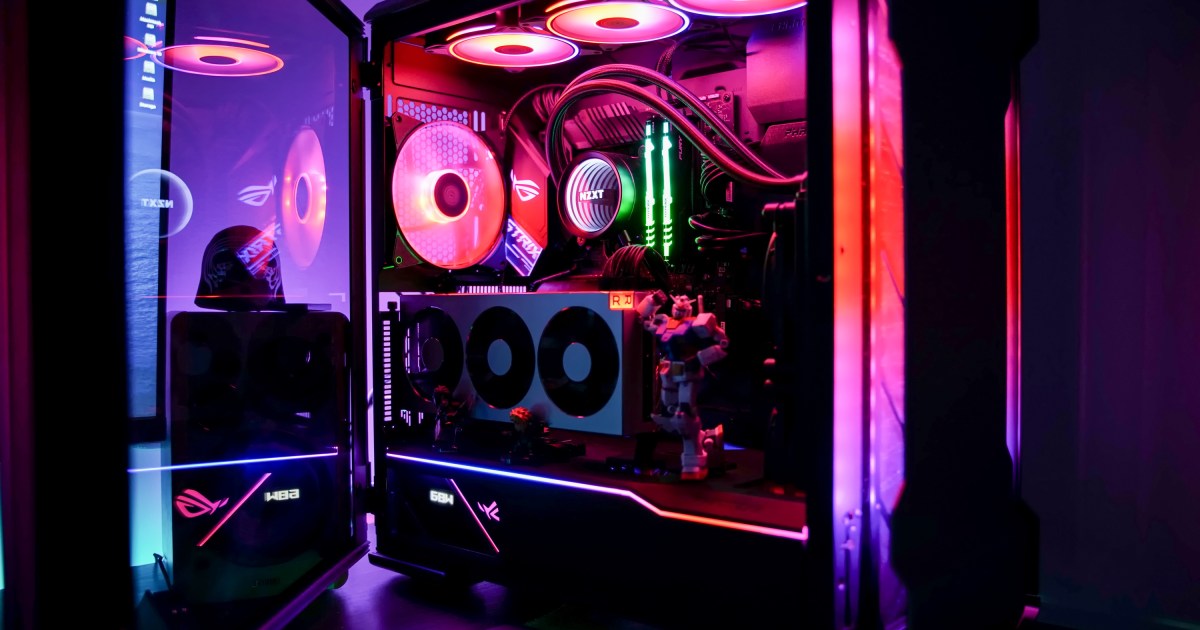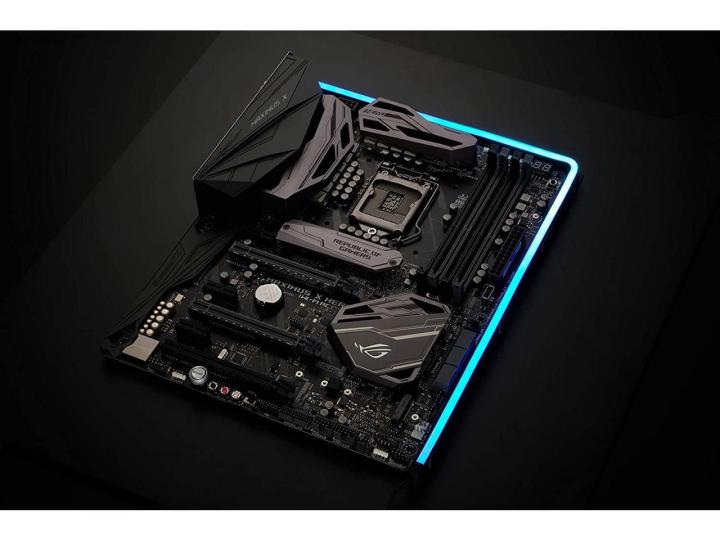Building a PC is not just about picking the best graphics card and processor — you often want it to look good, too. After all, this box of entertainment is going to sit in your space for the next few years, so it’s only natural that you might want it to fit well.
Some people hate RGB, and some people swear by it. No matter which camp you’re in, there are ways to transform your PC from bland to interesting, and not all of them involve flashing lights. Here are some options to get inspired.
Install some RGB strips
Do you just want a bit more shine inside your PC but don’t necessarily want to spend a fortune to achieve it? RGB strips (also called LED strips) will give you the best bang for your buck.
If you’re unfamiliar with them, an RGB strip is a flexible length of LED lights that you can attach inside your PC case. Those lights can often be configurable, so you don’t necessarily need to aim for a full rainbow of colors. You can set them up to match the aesthetic of your PC and/or your room and stay that way.
The strips usually come with an adhesive of some sort and can be installed inside or outside your PC case. You can be as extra as you like with these, either settling for a single bar at the bottom of the case or lining most of your case with lights.
In modern motherboards, these strips plug into the RGB header and receive both power and signal from the motherboard. Sometimes, you’ll run into models that need to be plugged into the power supply, usually via a SATA connector. You can also buy an external RGB controller, such as this Cooler Master Mini. They can usually be daisy-chained if the number of headers is an issue, just like RGB case fans can.
One word of warning: RGB strips and case fans can be pretty confusing.
Most RGB strips, like this
combo set, are affordable and can be bought for as little as $10. That’s cheaper than adding extra RGB fans, but they do nothing for your PC other than boost its aesthetic. A fan will also supply more airflow, and that’s always nice in beefy gaming builds where improving the cooling is an important goal.
One word of warning here is that both RGB strips and case fans can be pretty confusing, and it’s easy to buy the wrong thing and then later on find out that it doesn’t fit. Like most PC building, buying the right set can require a lot of research. Study the specs of your motherboard and then the fans in question and make sure they share the same connector, such as a 3V, 5V, or 12V. Then, read up on whether they’re addressable (ARGB) or not, meaning whether each LED can be controlled separately. Believe it or not, that, too, can cause problems in terms of compatibility. There’s also the question of the pin layout. A quick TL;DR is to look for what matches your motherboard’s headers perfectly.
All this extra reading can make the prospect of setting up RGB strips and/or fans sound pretty daunting, but it’s really not so bad once you figure out the headers supported by your motherboard.
Liquid cooling
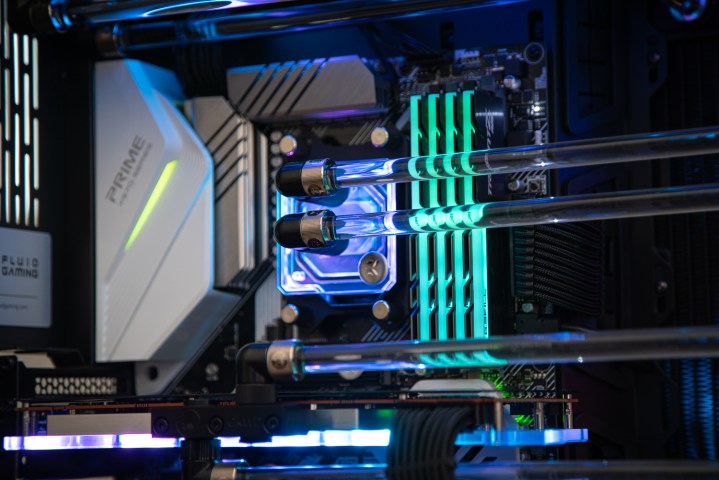
A CPU fan is necessary for almost all of the top processors, and you’ll often want to go with a third-party model for the pricier chips instead of using the stock fan that comes with the CPU (if it even comes with one). There’s plenty of room for some RGB action there, but if you really want supreme aesthetics, it’s hard not to mention liquid cooling setups.
When I say liquid cooling, I’m mostly referring to the more approachable option, meaning all-in-one coolers (AIO). A custom loop can look much better than AIO in a PC, but the barrier to entry is a lot higher, so you’ll need to do a fair bit of reading before you’re ready to give it a go. It’s very satisfying once it’s up and running, though.
Liquid cooling can sound scary at first, what with the idea of putting water into your PC and letting it potentially ruin all those expensive components — but this is a common misconception. High-quality AIO liquid coolers are safe and don’t require that much more maintenance than an air-cooled system. They’re generally much more efficient than air cooling, too.
Assuming you’re going with an AIO cooler, they bring a certain aesthetic to your build that can’t really be matched by a bulky CPU fan. It all looks quite high-tech and sophisticated, and with RGB options, a liquid cooler can become a quite striking component inside your PC build. The end result is sleek and clean.
Many water blocks and reservoirs come with integrated RGB lighting that can usually be controlled by proprietary software or the same software as the rest of your setup (usually something supplied by your motherboard manufacturer). Aside from RGBs, you can often pick up some colored coolant to fill the pipes with something that matches your style.
When it comes to liquid coolers, it’s important to research and ensure they’ll fit. This requires matching them to the rest of your components, but chiefly the PC case. Depending on your setup, there are some fun and efficient options, so check out our guide to the best AIO coolers to pick the one that suits your build.
Upgrade your PC case

Although some of us remember the days when PCs used to belong in boring gray cases, those days are gone now, and oftentimes, you might actually struggle to find a plain black (or gray, even more so) case with no side panel and zero RGB. RGB can be turned off, but the side panel has become such a staple that wanting to hide all of your components from sight can be an issue. But I digress.
The PC case is one of the most impactful components when it comes to choosing your personal style. It’s responsible for both the inside and the outside, setting the stage for all the other parts, which is why buying a PC case should be done early on if you’re focusing on aesthetics.
Cases come in all shapes and sizes. There are behemoths like the Hyte Y70 Touch pictured above, but there are also mini-ITX that are comparatively tiny and will fit a small desk just fine. No matter the form factor, the best PC cases offer lots of airflow, ports, and, most of all, stylish options.
A common choice is a standard RGB case, meaning a black chassis with some RGB fans inside. These can be either really cheap or extremely expensive, and the case will often support adding extra fans for better airflow (and more bling). In this category, the
is a popular choice, but there are really lots of options depending on what fits your needs. Some really take the gamer branding to the next level, like this
(priced at an eye-watering $500).
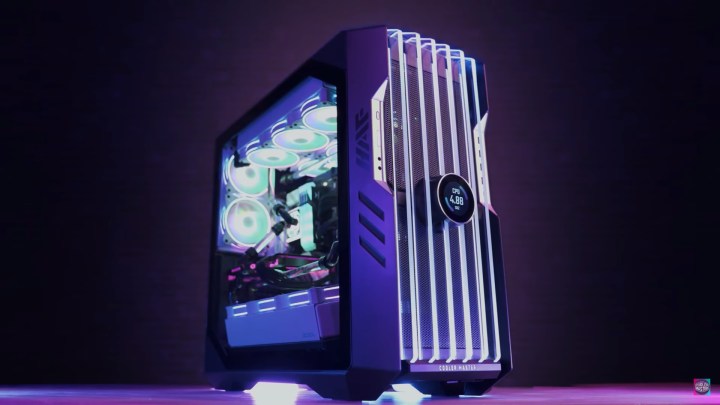
Since this type of case has become a staple in the gaming PC market, many brands started to stray from it and try to serve up something different. Take the
as an example — it’s unique and stylish, and although it can house high-end components just fine, it won’t stick out like a sore thumb if you install it in your office.
PC cases almost commonly come in black, but there are plenty of aesthetically pleasing options in white, too. There’s the
, for instance, or the
.
Some people ignore the case and just mount their PCs on the wall or inside their desks. That’s another option to explore if you have the time and the money to do that with your computer. One good thing to say about a wall-mounted PC is that the airflow shouldn’t be an issue.
Cable management is key
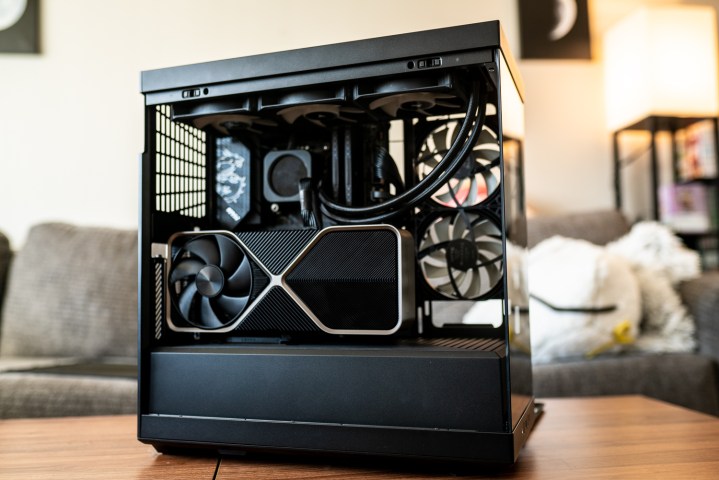
Ah, cable management. It’s arguably one of the best and worst things about building your own PC. It’s incredibly satisfying when done right, but equal parts frustrating at times. Choosing the right hardware can help make it less annoying and more fun to set up, though.
I shudder when I think of the first PC I ever built and the complete mess that I made out of the cabling. Fortunately, the case didn’t have a side panel, so I could sweep it all under the proverbial rug and forget until it was time to open it up.
These days, manufacturers support tidy cable management. It’s not just better for aesthetics but also for airflow and ease of access, and hey — if you have all those cool-looking components, you don’t want to cover them up, right? This is why it’s worth investing the time and the money into proper cable management.
Certain motherboards exist that almost completely strip your PC of all the visible cabling.
Certain motherboards exist that almost completely strip your PC of all the cabling — at least on the surface. However, they’re few and far apart.
is a Z790 motherboard that moves all the cabling to the underside of the motherboard, so the visible top side is fully cable-free. While it can be found for sale, it’s only available as part of a huge bundle with an RTX 3070 and a pre-fitted case. You most likely can’t use this motherboard outside of Gigabyte’s own hardware, though, and there aren’t too many fan headers — fortunately, daisy-chaining should work.
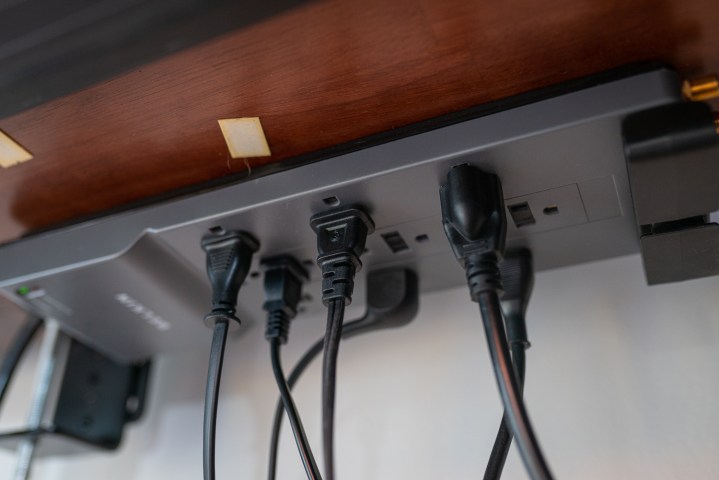
MSI has its own minimalistic motherboard, referred to as Project Zero, where all the fans and connectors are moved to the back of the board. It’s available in AMD (
) and Intel (B760M) flavors, and it’s only compatible with six cases in total as of right now.
Do you know what’s even worse than clutter inside your PC? Clutter outside of the case, and that can be tricky to avoid. With just about a million different cables going in and out of your computer, all it takes is a glance for them to mysteriously end up completely tangled. We have some cable management tips if you want to get that cleaned up.
Color matching

I’ve talked about white PC cases above, but you can get other components in white shrouds if you want everything to fit a certain color scheme. Those parts also often serve up some RGB, so if you’ve been dreaming of a mix of white and pastel lighting, it’s totally possible.
Let’s start with motherboards. At a premium, you can get most of the top motherboards in white, such as the
. It’s worth noting that this board costs up to $70 extra when in white, but hey — the mobo is the biggest component inside your PC, so the white model looks great over a white background.
Many of the best RAM kits, be it for DDR4 or DDR5, also come in white. It’s not uncommon for these to cost slightly more than their plain black counterparts, but unlike the motherboard, it’s usually a $5 to $10 difference. Liquid coolers and CPU air coolers, as well as regular case fans, can all be found in white and with RGB options included.

A newer trend that many manufacturers picked up on is graphics cards in full white shrouds. The premium you’ll pay for those is much higher, but if the rest of your build is decked out in white, a black GPU can look a bit jarring — unless you’re aiming for a monochrome look, which is fun, too. Even high-end GPUs like the RTX 4090 can be bought in white, and a lot of the more affordable models are up for grabs, such as
.
Not into the whole all-white aesthetic? No problem — there are lots of options in other colors, although matching the entire build gets trickier. The pink PC case by
is actually a solid option on top of being pretty cute, but you’ll struggle to find pink RAM or GPUs to match. However, you can mix things up and add some RGB strips to achieve the look you want.
Whether you go for something absolutely outrageous or a minimalistic approach, decking out your PC in some extra bling is pretty fun. It’s not for everyone, but once you build a PC, it’ll last you for years, so there’s no reason not to adapt it to fit your personal style. Just remember to double- and triple-check that it all fits together, or the fun lighting bonanza you’ve been hoping for might turn into disappointment.
Editors’ Recommendations

